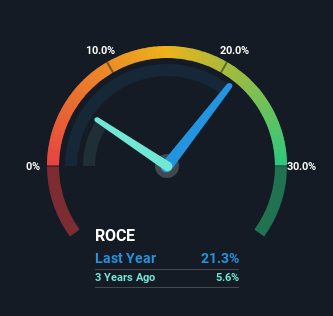- India
- /
- Electrical
- /
- NSEI:TDPOWERSYS
Investors Shouldn't Overlook TD Power Systems' (NSE:TDPOWERSYS) Impressive Returns On Capital
If you're looking for a multi-bagger, there's a few things to keep an eye out for. In a perfect world, we'd like to see a company investing more capital into its business and ideally the returns earned from that capital are also increasing. This shows us that it's a compounding machine, able to continually reinvest its earnings back into the business and generate higher returns. So when we looked at the ROCE trend of TD Power Systems (NSE:TDPOWERSYS) we really liked what we saw.
Understanding Return On Capital Employed (ROCE)
Just to clarify if you're unsure, ROCE is a metric for evaluating how much pre-tax income (in percentage terms) a company earns on the capital invested in its business. To calculate this metric for TD Power Systems, this is the formula:
Return on Capital Employed = Earnings Before Interest and Tax (EBIT) ÷ (Total Assets - Current Liabilities)
0.21 = ₹1.4b ÷ (₹10b - ₹3.3b) (Based on the trailing twelve months to September 2023).
So, TD Power Systems has an ROCE of 21%. In absolute terms that's a very respectable return and compared to the Electrical industry average of 18% it's pretty much on par.
See our latest analysis for TD Power Systems

Historical performance is a great place to start when researching a stock so above you can see the gauge for TD Power Systems' ROCE against it's prior returns. If you'd like to look at how TD Power Systems has performed in the past in other metrics, you can view this free graph of past earnings, revenue and cash flow.
So How Is TD Power Systems' ROCE Trending?
We're delighted to see that TD Power Systems is reaping rewards from its investments and is now generating some pre-tax profits. Shareholders would no doubt be pleased with this because the business was loss-making five years ago but is is now generating 21% on its capital. And unsurprisingly, like most companies trying to break into the black, TD Power Systems is utilizing 50% more capital than it was five years ago. We like this trend, because it tells us the company has profitable reinvestment opportunities available to it, and if it continues going forward that can lead to a multi-bagger performance.
What We Can Learn From TD Power Systems' ROCE
In summary, it's great to see that TD Power Systems has managed to break into profitability and is continuing to reinvest in its business. Since the stock has returned a staggering 1,125% to shareholders over the last five years, it looks like investors are recognizing these changes. So given the stock has proven it has promising trends, it's worth researching the company further to see if these trends are likely to persist.
One more thing: We've identified 3 warning signs with TD Power Systems (at least 1 which is potentially serious) , and understanding these would certainly be useful.
If you'd like to see other companies earning high returns, check out our free list of companies earning high returns with solid balance sheets here.
Valuation is complex, but we're here to simplify it.
Discover if TD Power Systems might be undervalued or overvalued with our detailed analysis, featuring fair value estimates, potential risks, dividends, insider trades, and its financial condition.
Access Free AnalysisHave feedback on this article? Concerned about the content? Get in touch with us directly. Alternatively, email editorial-team (at) simplywallst.com.
This article by Simply Wall St is general in nature. We provide commentary based on historical data and analyst forecasts only using an unbiased methodology and our articles are not intended to be financial advice. It does not constitute a recommendation to buy or sell any stock, and does not take account of your objectives, or your financial situation. We aim to bring you long-term focused analysis driven by fundamental data. Note that our analysis may not factor in the latest price-sensitive company announcements or qualitative material. Simply Wall St has no position in any stocks mentioned.
About NSEI:TDPOWERSYS
TD Power Systems
Manufactures and sells AC generators and electric motors in India, Japan, the United States, Europe, and Turkey.
Flawless balance sheet with solid track record.
Market Insights
Community Narratives



